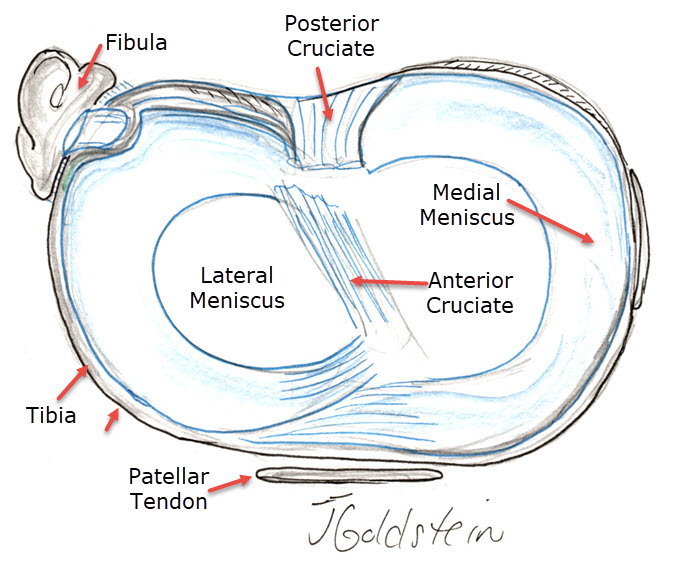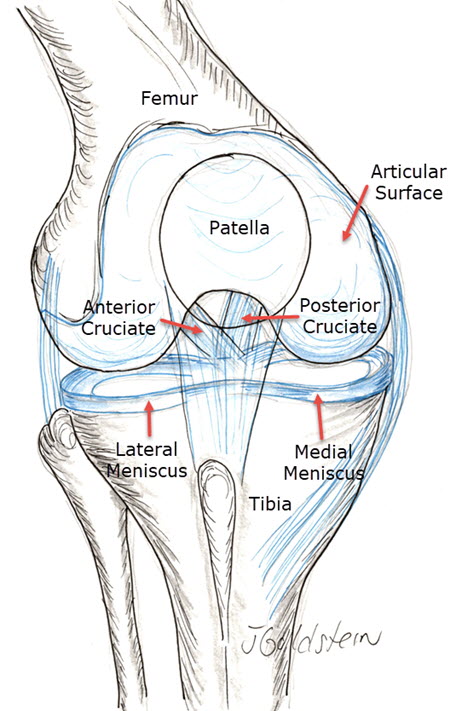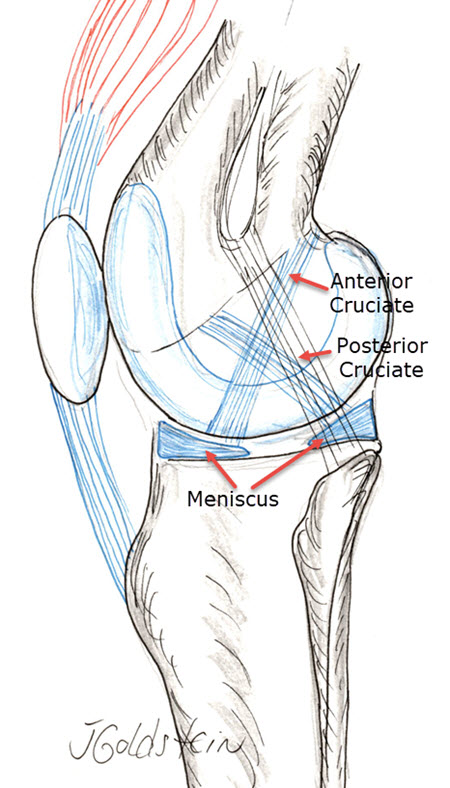Meniscal Tear of the Knee
Post Operative Instruction After Arthroscopy
The most common knee injury is related to the semilunar (meniscus) cartilage tear. There are two of these in each knee. One is medial (on the inside) and the other is lateral (on the outside) of the knee. Each appears like a crescent moon and is attached on its outer edge to the knee capsule and at each end to the tibia by ligament attachments. The meniscus is responsible for a four-fold increase in surface contact between the bones of the knee (tibia and femur). The meniscus also aids in shock absorption between the joint surfaces and aids in knee stability and lubrication. Complete loss of the meniscus is known to cause eventual arthritis. Each meniscus is made of cartilage. The outside one third has a blood supply and the capacity to heal. The inner two-thirds of the meniscus has more limited capacity to heal. A tear of the meniscus may occur following major trauma or none at all. This depends on the age of the individual and prior injury and activities. Not all tears are symptomatic, and many older patients are unaware they have a tear. Symptomatic tears are those which cause knee pain, locking, knee catching, clicking, stiffness, or recurrent swelling. Untreated symptomatic tears may cause perman
 ent damage (arthritis) because the torn meniscus rubs on the surface of the joint like “sand in a ball-bearing”. These tears are best treated early.
ent damage (arthritis) because the torn meniscus rubs on the surface of the joint like “sand in a ball-bearing”. These tears are best treated early.
DIAGNOSIS
Diagnosis of a meniscal tear is often straight forward on physical exam. In other cases, especially if symptoms are subtle or intermittent, or coexist with arthritis, diagnosis is more complicated. In this case knee, MRI (magnetic resonance imaging) may demonstrate the presence or absence of significant meniscal tears. MRI uses a large magnetic field and radio waves (no X-ray) to create multiple pictures of the knee. MRI can detect meniscal tears and ligament injuries with greater than 95% accuracy. MRI is a very expensive test. It is therefore reserved for cases where physical exam and symptoms are not typical. It generally requires 30-40 minutes and may be hard to perform in patients with claustrophobia who have difficulty tolerating the confines of the scanner. Magnetic metals embedded in the body are a contraindication to performing the test. Very heavy patients may require the use of a special scanner made to accommodate their size and weight, or MRI may just not be possible, as in patients with a pacemaker. An Arthrogram is an older technique used to demonstrate meniscal tears. It is performed by injecting iodine-containing contrast material into the knee followed by multiple plain X-ray images taken to show the “dye” within the meniscus where it doesn’t belong. This is a more invasive test requiring an injection of contrast, and cannot be performed in patients with iodine or shellfish allergy. It, unfortunately, has only an 85% accuracy in demonstrating meniscal tears and is even less reliable in documenting ligament injuries. 
 Orthopedic SURGERY
Orthopedic SURGERY
Meniscal tears are now treated arthroscopically. The Arthroscope is a small fiber-optic telescope used to look into the knee. Although general anesthesia is often used, arthroscopy may be performed with regional anesthesia (“local block”) or even local anesthesia with IV sedation with little discomfort. Total relaxation is required to fit the small instruments required into the knee and perform the necessary surgery without damage to the joint surfaces. The geometry of meniscal tear and the age of the patient dictate meniscal tear repair vs. partial resection. In general, tears in young patients at the outer edge of the meniscus may be repairable. Older patients generally have tears which are due to wear and tear and are less likely to be repairable. The healthiest knee is one with all its original parts. Meniscal preservation is therefore attempted whenever possible. Meniscal repair requires suture of the torn parts together. This can be performed arthroscopically but may require a secondary incision utilized to protect important nerves and vessels. If meniscal tear accompanies ligament injury, then ligament reconstruction is recommended. This is especially important if meniscal repair is performed.
RECOVERY
The time required to recover from a meniscal tear is variable. This is because of the variability of tear geometry. Associated ligament injury or surface damage to the joint surface may affect recovery. In addition, partial meniscectomy requires little protection after surgery whereas repair of a torn meniscus necessitates protective rehabilitation for 3-4 month
REHABILITATION
After Arthroscopy describes early postoperative treatment after meniscectomy or repair. Simple partial meniscectomy generally needs no formal physical therapy. A few days to a week of protected weight-bearing with crutches and rapid restitution of normal activities is encouraged. Occasionally therapy is needed to aid the return to normal motion and strength, but this is relatively rare. Meniscal repair requires protected weight bearing with bending, and normal weight-bearing on an extended knee rapidly after surgery. Return to normal sports after a meniscal repair is generally possible after about 4 months.
CONCLUSION
Not all tears of the meniscus require surgery. Only some knee problems are related to a torn meniscus. Meniscal tears may become symptomatic after an acute injury or gradually with no known injury. Symptom-free tears may become symptomatic with aggravating activities.
A symptomatic tear treated arthroscopically usually results in a return to full activity. Rehabilitation following meniscal repair takes about 4 months until complete recovery.
Compliments of Sports Medicine and Orthopaedics, East Providence, Rhode Island
